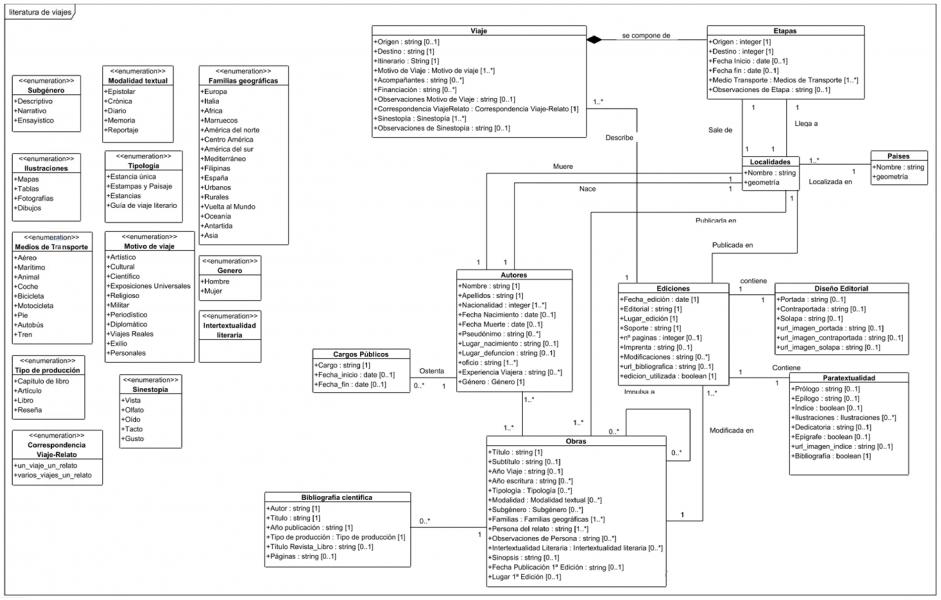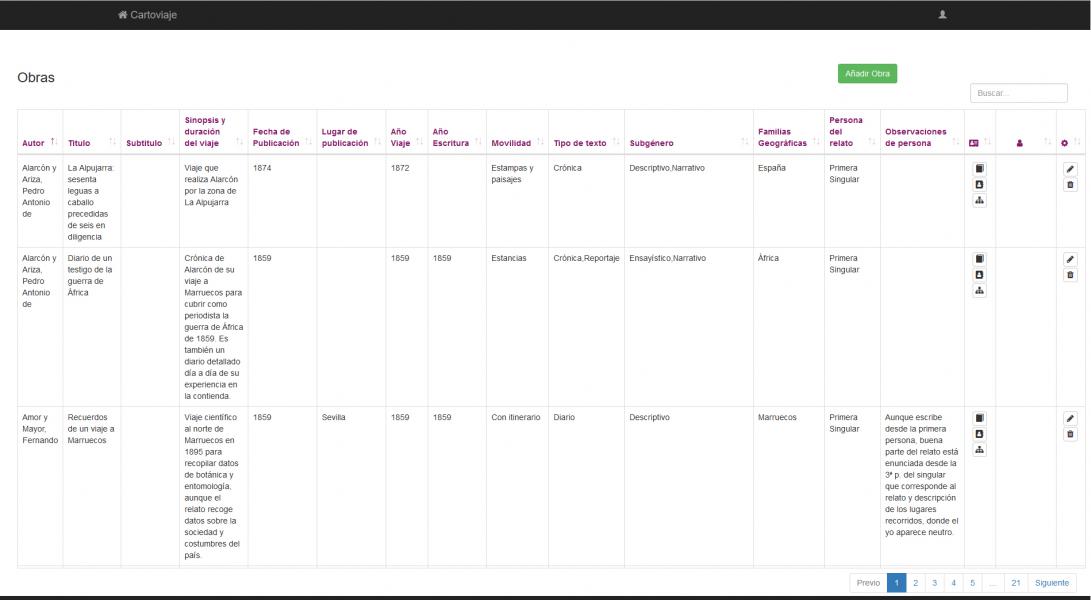"Travel stories", literary realities, at times, marginalized of the canon
CARTOVIAJE. Cartocronography of contemporary spanish travel narrative (XIX & XX centuries)

The project aims to locate, delimit and geographically order the travel destinations of the writers of "travel stories" of the nineteenth and twentieth centuries; to organize the possible subgenres according to the different families of "travel stories", taking into account the context (political, cultural, commercial, diplomatic or simply, personal); and to establish the intertextual relations that, in many cases, derive from the influence exerted by an author and his narrative at a given moment.

Definition of the travel narrative genus:
"It consists of a factual discourse that is modulated on the occasion of a journey (with its corresponding marks of itinerary, chronology and places) and whose narration is subordinated to the descriptive intention, which endows the genus with a certain dose of realism. It usually adopts the first-person (sometimes third-person) point of view, which always invokes us the figure of the author as a witness to the events and appears alongside certain literary figures that, although not exclusive of the genre, at least shape it. [...] The marks of paratextuality (as a correlate of the factual modality) and intertextuality are characteristic, though obviously not exclusive either, of these 'travel stories'. There is no doubt that the limits of this genus are not clearly defined. It should be noted, however, that in its successive manifestations, the boundaries of the genre acquire more defined contours. That is to say, although its origins are more evanescent, it is possible to propose characteristics that distinguish it from the other bordering genres and that settled it with the passage of time. Otherwise, it is the usual. No genre began its journey as such. Only after some time we are able to baptize something that already has a solid trajectory."
Luis Alburquerque García, "El relato de viajes: hitos y formas en la evolución del género", Revista de Literatura 2011, p. 33.
Instituto de Lengua, Literatura y Antropología (ILLA). CSIC
The greatest strength and originality of the project lies in the cartographic ordering of 'travel stories', which emphasizes a way of seeing culture through a vector prism, that of spaces (countries, continents, regions), that tunes with the studies of the 'literary field', since it welcomes literary realities that, at times, have been marginalized of the canon.
This project seeks the systematization and study in geographic code, in order to observe the reinforcement, continuity, decay or disappearance of travel to certain places or countries within or outside national borders in the course of the nineteenth and twentieth centuries. Hence the reference in the title to the chronography, since we observe how certain subgenres of the 'narrative of travel', with a strong presence in the nineteenth century, disappeared gradually after the wear of the impulse that motivated them.
The proposal on which this project is based considers it essential to establish the category "travel narrative" within the amalgam of texts and categories included in the label "travel literature". For this purpose, it proposes the geographical criterion as the axis of the classification of the works that are subsequently categorized according to the scheme of subgenres of the nineteenth and twentieth centuries. Its connection with the Digital Humanities emanates from the spatial, "cartographic" axis, which is materialized in the design of a conceptual data model in UML (Unified Modelling Language), with the data of the author, literature, destination, travel, actors, travelers, means of travel, textual modality, time, descriptions, addressee, etc. This model has been implemented in a PostgreSQL relational database that is fed by the "Cartoviaje" application , which is a data entry interface that can be exploited in a GIS (geographic information system).

UML data model

Works-authored data entry application
Project goals:
- 1) Establish the text corpus of nineteenth and twentieth centuries of 'travel narratives' based on what has been termed "cartochronography".
- 2) Establish the travelers' destinations for their subsequent grouping into subgenres in both the nineteenth and twentieth centuries.
- 3) Establish the textual families according to the subgenres of the stories in relation to the destination of the traveling writers.
- 4) Select the works that are at the origin of the text families (the hypotexts) and Analyze them in detail in order to add the data of the authors and works to the database.
- 5) Elaborate metadata, which serve in a double sense: as a guideline for the analysis of the works and as a main source for the database.
- 6) Establish the keys of the poetics of each of the authors considered, so that their evolution can be observed.
- 7) Disseminate the results.
The project is structured in three clearly differentiated levels:
a_The selection of works that respond to the characterization of the genre according to three aspects, the factual versus fictional character, the primacy of the descriptive versus the narrative and its testimonial character.
b_The fixation of the geographical spaces that will determine to a great extent the division of the stories into subgenres.
c_The studies of the canon recovering for the literary canon, on the one hand, the non-fictional texts considered as "extravagant" and on the other hand, the texts of little-known authors who have written interesting travel stories. These works will be incorporated into the canon duly contextualized and classified in their corresponding textual families.
I.P.: Luis Alburquerque García - ILLA. CSIC
His academic activity is in the area of Literary Theory and Comparative Literature. He specializes in rhetoric and poetics, especially of the Golden Age, and in recent years has focused numerous studies to the analysis of travel literature, mainly Hispanic, addressing issues of literary genre.
read more...
